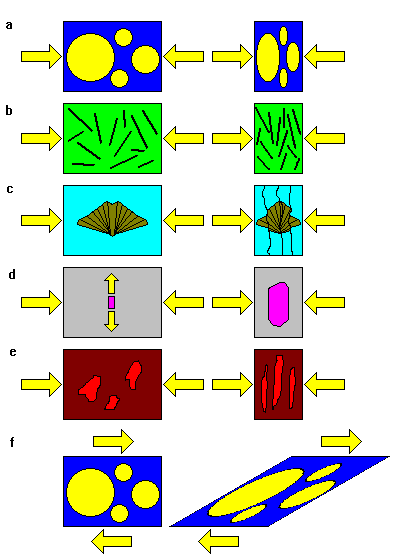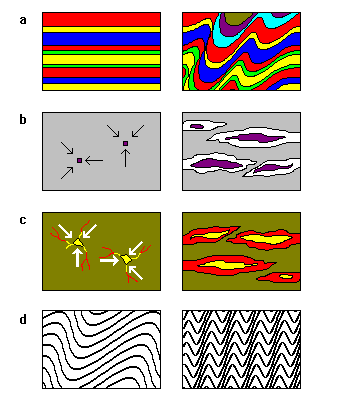Small Scale Ductile Deformation Structures
Steven Dutch, Professor Emeritus, Natural and Applied Sciences,University of Wisconsin - Green BaySmall scale ductile deformation structures occur on scales from microscopic to a few meters, and are useful because they provide clues to larger structures. Important structures include:
- Foliation: sheetlike texture due to flattening of the rock
- Lineation: elongation of the rock in one direction resulting in a linear structure
- Small folds: especially asymmetric folds produced by shearing
- Boudinage: tensional breakup of rock layers
- Deformed structures of known original shape, like fossils or concretions
- Rotation and shear-sense indicators
- Strain shadows: gaps produced when the surrounding rock pulls away from a rigid object like a pyrite crystal.
Foliation
Foliation is a sheetlike structure that forms when rocks aredeformed. As the figures show, it forms in a variety of ways, butin every case, the foliation is at right angles to thedirection of greatest compression.
| a. Foliation can simply form when objects in the rocks are
flattened. b. Foliation can form when flattening causes platy mineral grains to align, much the way toothpicks would be aligned when swept up by a broom. c. Solutions often remove large amounts of material from rocks as they are being deformed. The solutions move in the direction of least resistance. d. Elongate crystals grow in the direction of least resistance. e. Pockets of molten material may form during high-temperature metamorphism, and these may be flattened. This is one possible way banding in gneiss forms. f. Shear, like along a fault, also produces foliation. As the shear deformation becomes greater, the foliation becomes stronger and more closely aligned with the fault plane. |
 |
 |
Deformed rocks develop a sheetlike structure called foliation. one way foliation can form is simply by flattening existing strucures in the rock. This rock near Gander, Newfoundland was once a conglomerate - granitic pebbles have been flattened by over 50 per cent but the black slate pebbles have been flattened almost paper-thin. |
 |
Some foliation forms when materials are removed from the rocks by solution. The fine parallel cracks in this fold formed that way. The solutions move in the direction of least resistance, parallel to the axial plane of the fold. |
Banding in Gneiss
| a. Often the banding in gneiss is a relic of original bedding,
especially if the original rocks had alternating beds of dissimilar
composition. b. As ferromagnesian minerals form, they accumulate iron and magnesium from their surroundings, which become depleted. The result is a mass of ferromagnesian minerals surrounded by quartz and feldspar. c. As rocks begin to melt, the granitic components melt first, following Bowen's Reaction Series in reverse. As the melt collects, the remaining rock becomes enriched in ferromagnesian minerals. This is another way to create alternating bands of light and dark minerals. d. As folding progresses, the sides (or limbs) of folds become progressively more thinned out. Alternating bands of segregated and finely-intermingled minerals result. |
 |
In reality, all of these mechanisms may be at worksimultaneously in gneiss formation.
Lineation
elongation of the rock in one direction resulting in a linear structure
Small folds
especially asymmetric folds produced by shearing
Boudinage
 |
When rocks are compressed, they often are extended at the same time
in some other direction. The granite dike cutting this gneiss near Bucksport,
Maine has been stretched until it broke into a series of discrete blobs,
a process called boudinage (from the French word for sausage.)
This is also a nice example of the adage "don't get mad, get even." The geologist mapping this area wanted to call the gneiss the Knox gneiss, but was told he could not because there was already a Knox Formation elsewhere in the U.S. (the U.S. Geological Survey will not recognize duplicated names). So he turned to a local Indian place name and called it the Passagasawakeag Gneiss. |
Deformed structures of known original shape, like fossils or concretions
 |
When objects of known shape deform, they are valuable indicators that allow us to quantify rock deformation. Fossils are good indicators. The light spot here is a reduction spot, a place where iron in the rock was chemically reduced and the reddish color of the slate bleached. The originally round spot (the object in the center that locally affected the rock chemistry is visible) has been deformed into a nearly perfect ellipse. The rock has been flattened in the direction of the short axis and lengthened in the direction of the long axis. |
 |
The upper surface of this outcrop in Ontario is a bedding plane. There is a crude foliation dipping to the left, suggesting the fold is an anticline with its crest off somewhere to the left. Also visible in the rock are several elliptical objects. They differ very slightly from the surrounding rock and are visible only as a result of weathering. One is just left of the hammer, another above and right of the hammer. Note that their short axis is perpendicular to the foliation. When we have several deformation indicators in the rocks, they usually tell a consistent story. |
 |
This is why these small structures are important. At the bottom
is another of the elliptical objects, visible because it weathered faster
than the adjacent rock. The geologic map above it shows the Sudbury
Basin, the pink oval with the green center. The outcrop is within the
Sudbury Basin. The Sudbury Basin is an ancient meteor crater, originally circular. It was deformed by a crustal event, as were the rocks within it. The ellipse in the rocks, a foot long, has the same shape as the Sudbury Basin, which is about 50 miles long. |
Rotation and shear-sense indicators
iygto
Strain shadows
: gaps produced when the surrounding rock pulls away from a rigid object like a pyrite crystal.
Return to Crustal Movements Syllabus
Return to Techniques Manual Index
Return to Professor Dutch's Home Page
Created
6 September 2006, Last Update